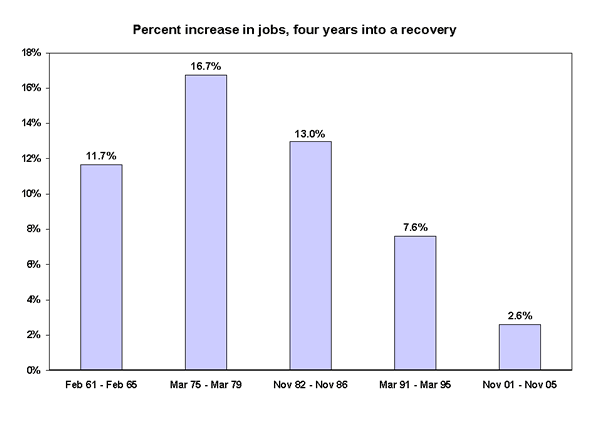December 2, 2005
Solid month for jobs, but long-term growth still lags
The nation’s payrolls regained their pre-hurricane momentum last month, increasing by 215,000 jobs in November, according to today’s report from the Bureau of Labor Statistics (BLS). Job growth was wide-spread across industries, with most sectors expanding, and the unemployment rate remained at 5.0%.
Even with revisions that added 13,000 to September and October’s payrolls, the employment gains in those two months of 17,000 and 44,000, respectively, were clearly depressed by the Gulf Coast hurricanes. Excluding those two months, average employment growth this year has averaged just under 200,000 jobs per month, a healthy growth rate, but one that remains below that of past recoveries at this stage.
About two-thirds of the 278 private-sector industries added jobs in November, the highest share since May of last year. Construction continues to be a growth sector, as the Gulf Coast reconstruction effort bolsters further the ongoing housing boom. Manufacturing employment is up 26,000 over the last two months, the first consecutive monthly gains since last spring.
Services added 165,000 jobs across all its major sectors. Food services bounced back after recent losses, adding 39,000 jobs in November, and job growth in professional services also increased, up 29,000. Notably, temp jobs were only a small part of that gain, as growth within the sector was among higher-paying sub-industries, such as computer design and management.
The retail sales sector is watched closely this time of year. Sales reports suggest a solid, if not especially strong buying season for retail goods. A common question in recent years has been whether the increase in retail sales over the Internet has dampened hiring in stores. Because the BLS adjusts its data to account for the annual sharp boost in seasonal hiring, today’s report shows but a small gain of 9,000 jobs. But the unadjusted “raw” data shows that retail hiring is up 356,000, or 2.3% over the previous month, just about average for November (unadjusted). This growth suggests that retailers have indeed boosted their staffing levels to meet the expected holiday demand.
Wage growth also accelerated, though it remains below the rates of inflation that have prevailed in recent months. On a yearly basis, hourly wages are up 3.2%, the fastest yearly growth rate since March 2003. The most recent inflation reading, however, shows prices rising at 4.3% (from October 2004 to October 2005).
There are signs in today’s report that suggest a weaker job picture than might be readily apparent from the common indicators. For example, average weekly hours were down by one-tenth of an hour (two-tenths for manufacturing), and were negative across most industries. At 33.7 hours per week for private-sector workers in blue-collar or non-managerial jobs, this measure of the strength of labor demand has remained unchanged over the past year, as well as over the recovery that began four years ago. In prior recoveries, average hours were up at this point.
The household survey also has some weak spots, especially regarding African Americans, whose unemployment rate jumped from 9.1% to 10.6%. That 1.5 percentage-point jump is the largest in the history of this series, which goes back to the early 1970s. It is difficult to know what caused this sharp spike. Employment in the notoriously volatile household survey fell in November by 52,000 overall and fell for blacks by 289,000, a result that is in stark disagreement with the more reliable establishment survey. This important indicator involves closer scrutiny in coming months.
Another important finding from today’s report comes from the BLS data on the employment status of hurricane evacuees (but only those who are not residing in hotels and shelters). These data show a tremendous employment advantage for minorities who have returned to their homes. For African Americans who have not returned, unemployment is 47%; for those who have returned, the rate is 8.9%. Note also that only one-third of blacks have made it back to the area, at least among the population covered in this survey (i.e., those not living in a hotel or shelter).
No such differential exists for whites, whose unemployment rates are 14% for those who have returned to the affected areas and 13% for those who are still evacuees.
Finally, last month represents the four-year mark in the recovery that began in November 2001. While job growth has been consistently positive since June 2003, among all recoveries that have lasted at least this long, the current one has been the worst on record (see the chart below). Over these years, the nation’s payrolls have increased by 2.6%, well below the rate of the other recoveries that have lasted this long, including the 1990s recovery, which also began as “jobless.”

In the midst of a spate of positive indicators—strong GDP growth, decent retail sales, increased capital investment, and the general bounce-back from the devastating storms—it is important to keep this long-term weak performance in mind, as it reveals a continuing gap between the overall performance of the economy and the strength of the labor market. It is the latter that is the source of improved living standards for the majority of working families, most of whom have lost ground in terms of wages and income over the past four years.
Today’s report was written by EPI economist Jared Bernstein, with research assistance from Yulia Fungard.
To view archived editions of JOBS PICTURE, click here.
The Economic Policy Institute JOBS PICTURE is published each month upon release of the Bureau of Labor Statistics’ employment report.
EPI offers same-day analysis of income, price, employment, and other economic data released by U.S. government agencies. For more information, contact EPI at 202-775-8810.